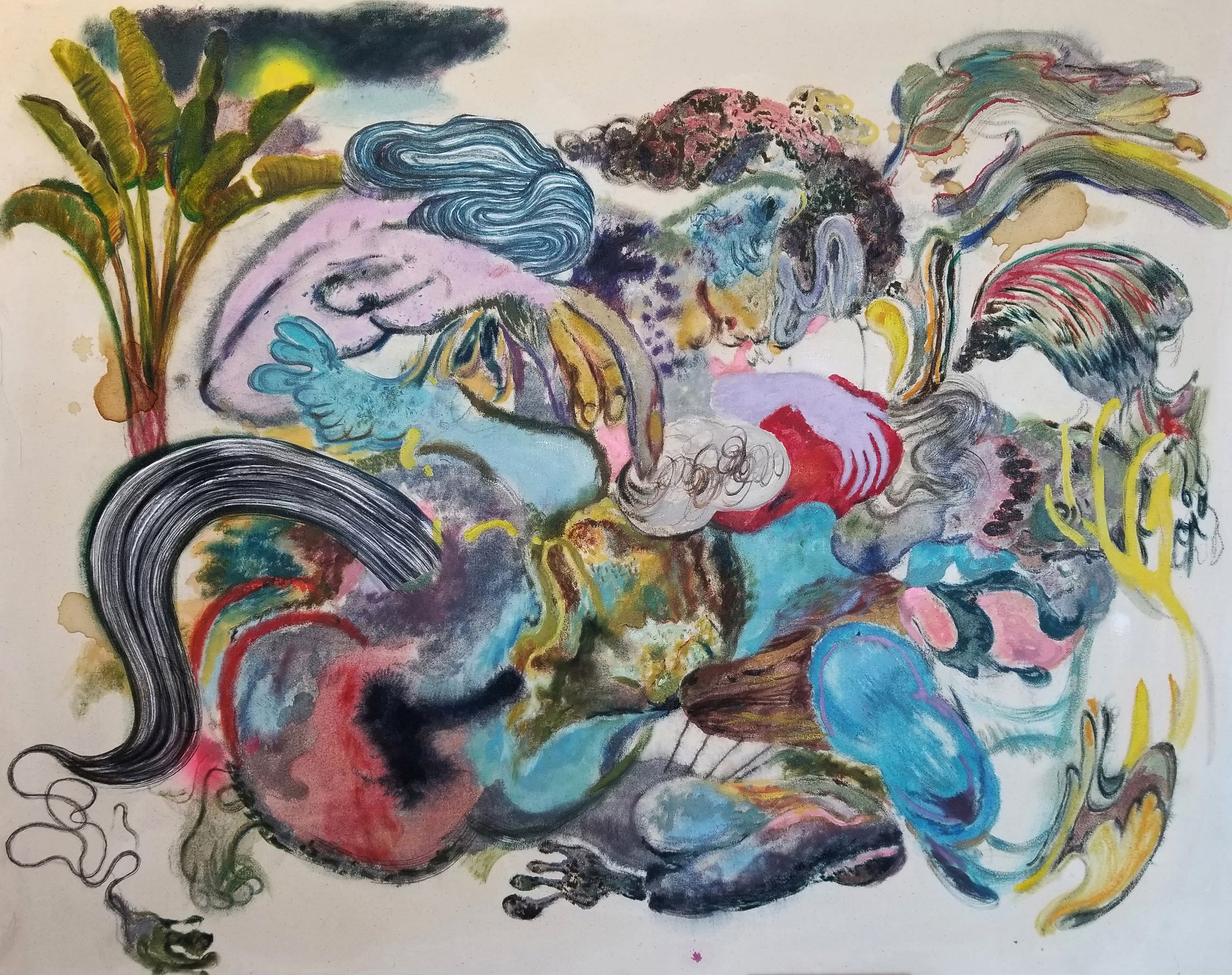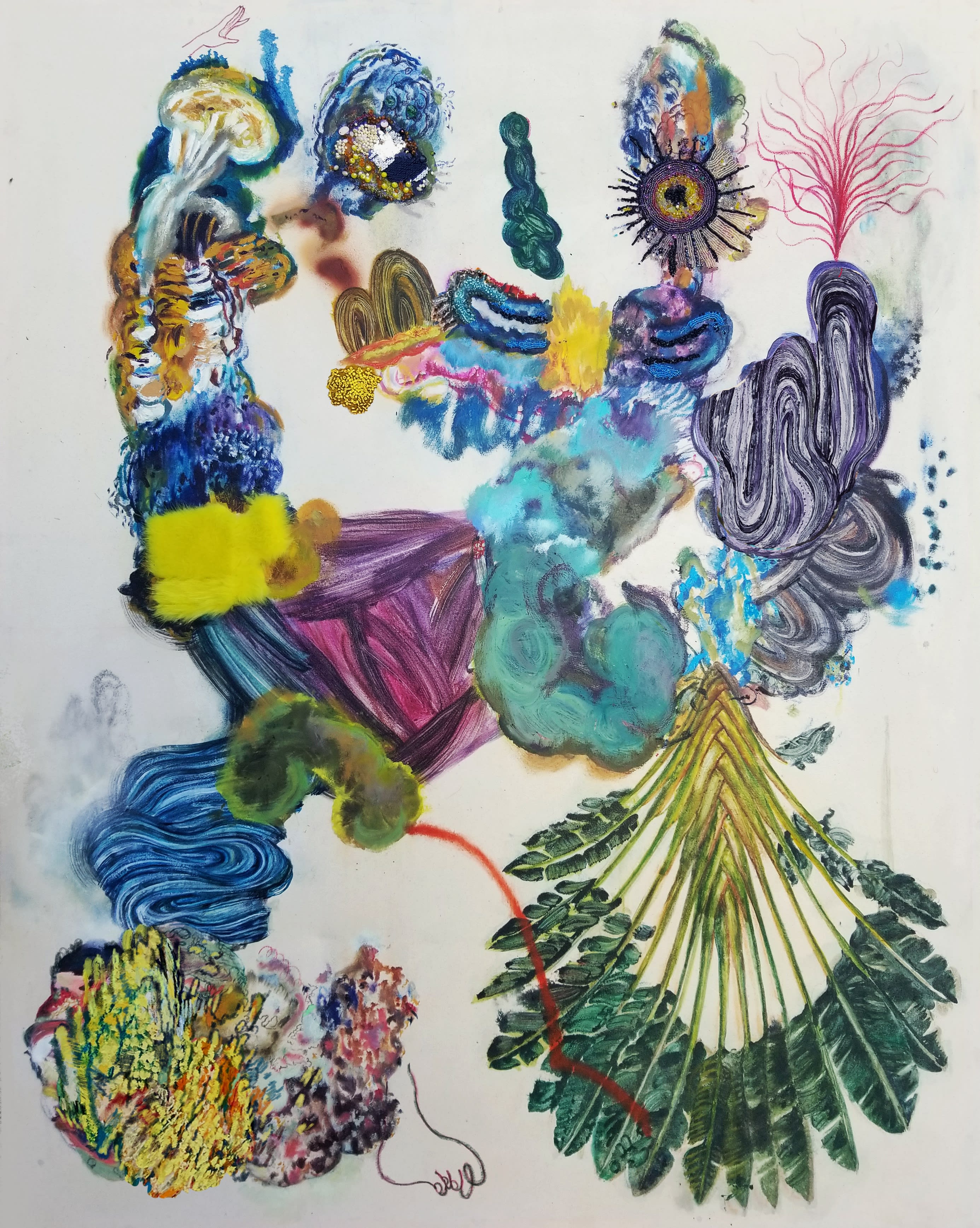LA based artist Ken Gun Min blends together Eastern and Western influences in his fluid, gestural painting. He is inspired by art traditions from both his native and adopted homelands, and explores mixing and merging these to create a hybrid aesthetic that is at once both influences and neither. His art explores many other dualities too; between masculine and feminine, abstraction and figuration, joyous and melancholic. Trained in both fine art and motion picture illustration, Ken incorporates an assemblage of styles and techniques in his art. It's not uncommon to see He-Man and Jacques-Louis David's Napoleon Cross the Alps Chinese floating mountains all in the same frame. This cultural mashup is Ken's way of locating himself within the two very different realities of East and West, but also within a visually saturated, hyperconnected digital world. Bringing together fragments of cultures, art histories and internet data, Ken's art is a response to our times where nothing and everything is both strange and familiar. In his most recent work, Ken uses a collage of oils and Asian pigments with beads and crystals on raw canvas. The loose, gestural swaths of color resemble rolling landscapes that slowly take shape into human forms. The sensual brushstrokes and suggestive features imbue the figures with a latent sexuality that is at once confrontational and subtle. Once again, Ken is playing with the many dualities, contradistinctions and expressions of masculine sexuality, and not without a sense of humor.
AMM: Hi Ken! Please tell us a little about your background and how you got started in the art world.
KGM: Hi ArtMaze Mag, I was born and raised in Seoul, South Korea. I studied Art history and studio painting in Hong-Ik University. Then I moved to San Francisco and studied production design and Illustration for motion picture and TV in MFA course at AAU. My love for contemporary art has grown bigger and bigger when I moved in Los Angeles after working in the TV industry for a decade, so I went on an artist residency in Berlin and Zurich for 2 years. It was a bit messy and a detoured path finding my way as a full time studio artist but I always knew that this is what I wanted to do.
AMM: Your paintings borrow and mash together an incredibly wide range of references - from Chinese ceramic painting to pop art, to classical Western art and much else in between. Please tell us about your style of your art and interest in these diverse references.
KGM: I am generally interested in translation and conversation: mostly in a visual form of interpretation. My fascination about ceramic painting started from a history between Dutch Delft Blue and Chinese blue and white pottery from the 16th century; how two cultures love/copy/develop each other's ceramic art or art in general. It inspired me to start my "translated landscape" series. This is ink drawings of mountains located in Marine County, California. It is about complicating the dynamics of Eastern/Western art history of sublime landscape genre: observer and their perception. For example, you have an image of Mt. Tamalpais rendered by traditional Asian landscape painting technique that other people perceive it as an Eastern landscape. Switching techniques and subject matter across time and place allows me to explore double consciousness as an immigrant artist. For pop and other Western art reference come in similar context as I mentioned above; conflict in culture and marginalization, however, I try to keep it less serious. Ioften find some of pop culture images in my paintings come from Twitter. I find it is incredible that people share their internal dialogue with the world.
AMM: How do you approach color in your paintings?
KGM: I usually make 5-10 color studies before I go to bigger canvas. I have tried a couple of times to go with intuition. It seemed like it worked at the moment but it didn't. Digital technique allows me to explore with different option. It really helps a lot.
AMM: Your paintings have a wonderful sense of movement. What is your process of working?
KGM: I design the path of movement if I can. I sometimes study/practice gestural abstraction stroke before I hit it in bigger canvas.
AMM: How do you know when a work is complete?
KGM: It actually never ends. Your vision keeps changing and the world is never settled, so it is very hard to tell when to stop. I sometimes revisit old paintings and revise them satisfactorily. However, you have to move on otherwise you could be trapped in your own past vision. Time tells me when a work is complete.
AMM: There are strong sensual and sexual undertones in your current work. Can you tell us more about this?
KGM: Yes, I think it is mostly shown from recent series, body(bodies). These images are representational, reflective of a body or the people that I know. They usually show off their physiques or wrestle-like act, either they want to be butch or femme. I wanted to portray them with duality and fluidity: dominant and submissive energies at the same time, happy but sad, abstraction yet representational. I also like to treat them in subtle ways although they are showing ejaculation, enlarged body part etc. It is a way of exploring humanity in a much less blurry way.

Moon Light, rabbit glue, oil paint, Korean pigment, glass bead, crystal on raw canvas, 38 x 48 inches.
AMM: In your artist statement you describe your conceptual interest in digital and other visual media. Please tell us how this translates in your paintings. In what ways are you influenced by popular culture and digital media?
KGM: Surfing through smart phones, monitors and books is like travelling in your unconsciousness. There is countless visual information being dumped into your awareness. These images are being infinitely reproduced and distributed, passing through your cognition filters to either be remained or to be trashed. I collect selective images in my material bank from time to time. I can find almost everything I am interested in online. My painting often combines references sourced from this collection; my own photography or commercial illustrations with an array of seemingly random copies or vintage animation clips or screen captures from random twitter feeds. These juxtapositions occur side by side or reconstructed on canvas. I am more interested in looking back on my selection process; how I select and use these images artistically. The flow of images shows and influences the way I make art, more specifically, influences the way I see and live.
AMM: How has your art changed over the years? What has inspired this?
KGM: Los Angeles has changed me and my art the most. The city has a very wide spectrum of people and local history. It does stretch my horizon and inspires me every day.
AMM: If you were a color, which would you be and why?
KGM: Black. It mutes out all other color and drops a shadow until it comes out in the light. It reminds me of patience and waiting. It exists for other colors.
AMM: Alongside your painting you also work in the film industry in the art department. This must be a really different experience than working on your own in your studio. Please tell us a little about it and what you enjoy about the work.
KGM: It is a totally different world. It is collaboration vs lone wolf and I really like both types of work.

Up side down, rabbit glue, oil paint, Korean pigment, glass bead, crystal on raw canvas, 68 x 53 inches.
AMM: What ideas are you exploring in your current work?
KGM: Living/working in Eurocentric capitals for almost two decades, my work often comes from challenging the first-world-oriented perspective. For the past year, my work has focused on the creation of cross-cultural figures (and space). One of my recent series is about creating a "body(bodies)". It is mostly heavily textured painting with gestural strokes and pastiche of collage with mixture of oil painting and Asian pigment with collected beads and vintage crystal on raw canvas. I collect fractured images of body parts from local gym/club, media or dating apps in Los Angeles area. Each part usually comes from a different shape, color and size of body but merged into one homogeneous figure with a sense of incompletion, imperfection, and striving towards where we find our humanity. The figures often pose showing off big muscles or the huge size of genitals, yet they also appear very feminine and delicate in manner. Its masculinity standing in the spotlight but in the shadows too, hyper visible and invisible.
AMM: Do you have any exciting projects coming up? What's next for you?
KGM: I started working with a really nice gallery who supports my vision and I am looking forward to what we can do together. I am planning to create a picture book with a new series of work and I designed a small theme park for Comic Con 2019. I can't wait to see it and how people enjoy them.

